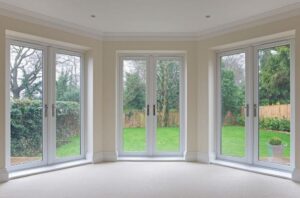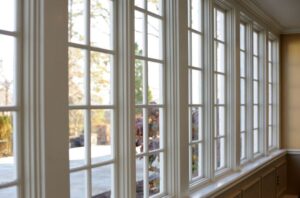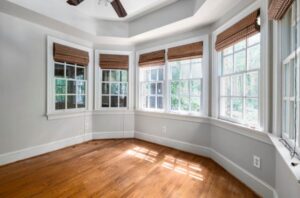In the competitive landscape of windows and doors, Weather Shield Windows vs Andersen stand out as industry titans.
Weather Shield, a family-run business for over 55 years, is celebrated for its high energy efficiency and quality in wood and aluminum products. Andersen, with its 155-year legacy, is recognized for durable, energy-efficient designs and pioneering innovations.
This article delves into a detailed comparison between these two brands, unraveling their key innovations, market positions, and unique offerings.
By understanding their distinct histories and contributions to the industry, we can better discern which brand aligns with your specific home needs.
Let’s explore what sets Weather Shield and Andersen apart.
Weather Shield Windows vs Andersen: Quick Comparison
| Feature | Weather Shield | Andersen |
|---|---|---|
| Company Background | Family-run since 1955, specializing in all-wood and aluminum windows and doors | Established 1903, known for durable and well-designed doors and windows |
| Marketing | Focus on product quality | Strong brand recognition through effective marketing |
| Key Features | Energy efficiency, durability, variety in hardware and colors | Energy efficiency, high-performance glass, various styles |
| Performance Data | U-Factor: Variable, Design Pressure: LC-PG50-H (~173mph), Air Infiltration: 0.12 cfm | U-Factor: Variable, Design Pressure: LC-PG30 (~131mph), Air Infiltration: <0.30 cfm |
| Product Line | Wide range, including specialty and historic designs | Broad range of window and door styles |
| Customization | Signature Series offers extensive color and wood options | 400 Series limited to specific colors and wood options |
| Frame Materials | Wood, aluminum-clad wood, vinyl, fiberglass | Wood, Fibrex composite, vinyl |
| Exterior Material | Extruded aluminum clad with AAMA 2605 finish | Vinyl clad frame with Fibrex sill |
| Glass Options | Double/triple pane, Low E, high wind resistance | Double/triple pane, Low E, insulated glass |
| Energy Efficiency | ENERGY STAR compliant, efficient designs | ENERGY STAR compliant, high-performance glass |
| Styles and Aesthetics | Focus on historic accuracy for old homes | Contemporary styles, smart home integration |
| Balance System | AAMA class 3 with stainless steel | AAMA class 2 with nylon string |
| Technology | Two operating sashes, integrated nail fin | Verilock security sensors, wireless sensors |
| Warranties | Lifetime for vinyl, 20 years for glass/parts | Lifetime for vinyl, 20 years for glass, 10 years for parts |
| Manufacturing Location | Medford, Wisconsin | Bayport, Minnesota |
| Service Reputation | Mixed, varies by dealer | Generally positive, company-backed support |
| Lead Times | Lengthy for custom windows | Lengthy during peak seasons |
| Price Range | Windows: $160-$1000, Doors: $500-$7000 | Windows: $400-$1000, Doors: $1870-$8170 |
| Design Flexibility | Specializes in historic designs | Larger window sizes, smart home options |
| Additional Considerations | Independent dealer installation | In-house certified installation |
| Pros and Cons | Pros: Wide selection, strong warranties, historic restorations; Cons: Longer lead times, limited tech options | Pros: Broad product selection, smart features, strong customer service; Cons: Style may not suit historic homes, higher costs for custom windows |
Overview of Weather Shield Windows
Weather Shield has steadily evolved over its 55-year journey, establishing itself as a notable player in the windows and doors industry.
This section explores the brand’s evolution, key features, and technological strides.
The Evolution and Specialties of Weather Shield
Weather Shield began as a family-run business and has maintained its commitment to quality and innovation. Their focus has always been on creating products that blend functionality with aesthetic appeal.
Specializing in all-wood and extruded aluminum windows and doors, Weather Shield has tailored its offerings to meet diverse architectural needs, from modern to traditional homes.
Core Features and Unique Selling Points
What sets Weather Shield apart are its core features:
- Energy Efficiency: Their products are designed for high energy efficiency, helping to reduce heating and cooling costs.
- Durability: Emphasis on long-lasting materials ensures that their windows and doors stand the test of time.
- Quiet Operation: Features like lifetime lubrication and stainless steel springs contribute to a seamless user experience.
- Customization: A wide range of jambs, interior wood options, hardware finishes, and exterior colors allows for personalized design choices.
Material and Design Diversity in Weather Shield Products
Weather Shield’s product range is a testament to their commitment to diversity in materials and design.
They offer:
- Various Materials: Choices include wood, aluminum-clad wood, vinyl, and fiberglass, catering to different aesthetic and functional preferences.
- Design Options: Their portfolio includes single hung, double hung, casement, and specialty windows, among others, offering solutions for various architectural styles.
Energy Efficiency and Technological Advancements
Energy efficiency is at the heart of Weather Shield’s product design.
Their windows and doors come with:
- Low U-Factors: Ensuring better thermal insulation.
- Advanced Glass Options: Low E glass contributes to energy savings and comfort.
- Technological Innovations: With features like lower sash operation and extensive molding choices, Weather Shield integrates technology seamlessly into their designs.
Note: Weather Shield’s approach to energy efficiency not only aligns with modern sustainability demands but also offers cost savings in the long run.
By blending traditional craftsmanship with modern technology, Weather Shield has carved a niche for itself. Their commitment to quality, customization, and energy efficiency makes them a strong contender in the market.
Overview of Andersen Windows
Andersen’s 155-year history in the industry is a story of innovation and excellence.
This section highlights their journey, key features, energy efficiency, and technological advancements.
The Journey of Andersen in the Industry
Andersen’s history is marked by continuous innovation and a commitment to quality.
Since its establishment in 1903, Andersen has become a household name in the windows and doors market, recognized for its durable and energy-efficient products.
The brand’s longevity and sustained success are testaments to its ability to adapt and evolve with changing market trends and customer needs.
Highlighting Andersen’s Key Product Features
Andersen’s products are known for:
- Durability: Using materials like Fibrex composite, which offer longevity and weather resistance.
- Design Diversity: A wide range of styles, including contemporary and traditional designs, caters to various architectural preferences.
- Customization: Options for different glass types, hardware styles, and finishes, allowing for personalized design solutions.
Andersen’s Approach to Energy Efficiency and Sustainability
Energy efficiency is a cornerstone of Andersen’s product design, featuring:
- High-Performance Glass: Various glass options that optimize energy use.
- Effective Insulation: Enhanced weather stripping and thermally efficient frame designs to reduce energy loss.
- Sustainability: Commitment to environmentally responsible manufacturing processes.
Technological Integrations and Style Offerings
Andersen combines technology with style through:
- Smart Home Technology: Integrations that offer enhanced security and convenience.
- Aesthetic Flexibility: Options ranging from sleek, modern designs to more classic styles.
Important Note: Andersen’s integration of smart home technology not only modernizes their offerings but also adds an extra layer of convenience and security to their products.
Andersen’s long-standing presence in the industry is backed by its ability to offer durable, energy-efficient, and technologically advanced windows and doors.
With a focus on customer-centric designs and sustainable practices, Andersen continues to be a leader in the windows and doors market.
Key Comparison: Weather Shield Windows vs Andersen Windows
In this section, we delve into a head-to-head comparison between Weather Shield Windows vs Andersen, focusing on their product variety, performance, aesthetics, pricing, and warranties.
Comparing Product Lines and Variety
Weather Shield and Andersen both offer an extensive range of window and door styles.
However, there are nuances in their offerings:
- Weather Shield: Specializes in a broad spectrum including single hung, double hung, casement, and specialty windows.
- Andersen: Also presents a wide array but with a focus on larger window sizes and smart home options.
Detailed Comparison of Performance Data
Performance is key in choosing the right window or door.
Here’s how they stack up:
| Performance Aspect | Weather Shield | Andersen |
|---|---|---|
| U-Factor | Variable based on options | Variable based on options |
| Design Pressure | LC-PG50-H, ~173mph | LC-PG30, ~131mph |
| Air Infiltration | 0.12 cfm | Less than 0.30 cfm |
Aesthetic Styles: Historical Accuracy vs. Modern Designs
The aesthetic appeal is a major deciding factor:
- Weather Shield: Known for historically accurate designs, ideal for traditional or older homes.
- Andersen: Offers contemporary and sleek styles, suitable for modern homes and those seeking smart home integration.
Pricing, Warranties, and Service Reputation
Cost and after-sales service are critical considerations:
- Pricing: Both brands have similar pricing structures, but specific costs can vary based on materials and customizations.
- Warranties: Weather Shield offers a lifetime warranty for vinyl products and 20 years for glass and parts. Andersen also provides a lifetime warranty on vinyl products, with 20 years for glass and 10 years for parts.
- Service Reputation: Weather Shield’s service can be mixed, depending on the dealer. Andersen generally has positive reviews, with strong company-backed support.
Note: While both brands have their strengths, the choice often boils down to specific needs like design preferences, performance requirements, and budget constraints.
This comparison provides a clear picture of how Weather Shield Windows vs Andersen stand against each other, helping you make an informed decision based on your unique requirements.
Which is Better? Weather Shield or Andersen
Choosing between Weather Shield Windows vs Andersen depends on specific needs and preferences.
This section aims to guide you through making a choice that best fits your architectural style, budget, and quality expectations.
Assessing the Best Fit for Different Architectural Needs
Both brands cater to different architectural styles:
- Weather Shield: Ideal for those restoring or living in historic homes, offering historically accurate designs.
- Andersen: Perfect for modern constructions, providing contemporary styles and smart home integrations.
Analyzing Customer Satisfaction and Service Quality
The level of satisfaction and service quality are key differentiators:
- Weather Shield: Varies depending on the local dealer, with some mixed reviews.
- Andersen: Generally receives high marks for customer service, backed by strong company support.
Price-Performance Ratio: Making the Cost-Effective Choice
Consider the value for money each brand offers:
- Weather Shield: Offers a wide selection with strong warranties, but may have longer lead times.
- Andersen: Known for its broad product selection and smart home features, though it may be more costly for custom options.
Final Recommendations Based on Specific Requirements
Making the final choice should be based on your unique needs:
- Historic Homes: Weather Shield is the go-to for maintaining historical integrity.
- Modern and Tech-Savvy Homes: Andersen is more suitable for contemporary designs and those desiring smart home technology.
Important Note: Both Weather Shield and Andersen meet ENERGY STAR standards, ensuring energy efficiency regardless of your choice.
In conclusion, whether Weather Shield or Andersen is better for you hinges on your architectural style, need for customer service, budget, and specific window and door requirements.
By weighing these factors against what each brand excels in, you can make a well-informed decision that aligns with your home improvement goals.
Conclusion
In our journey through the nuances of Weather Shield Windows vs Andersen, we’ve uncovered their strengths and distinctions.
Looking ahead, we can expect further innovations in energy efficiency and smart technology in windows and doors. The choice between Weather Shield and Andersen ultimately hinges on your specific needs and architectural style.
Remember, the best decision is one that aligns with your personal preferences, home’s character, and lifestyle requirements.
As we embrace future advancements, let your individual needs guide your choice in this ever-evolving market.





